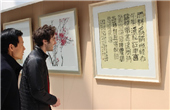The impact of calligraphy on Chinese culture
china.org.cn / chinagate.cn, April 28, 2015 Adjust font size:
Duanmu Liyin, dean of the Funing Painting and Calligraphy Academy.
Duanmu Liyin is dean of the Funing Painting and Calligraphy Academy and a member of the Chinese Calligraphers Association. His works of calligraphy have been shown across China at competitions and showcases, some of which have commemorated the founding of the country and Party.
Displayed on vertical scrolls or horizontal sheets of paper, Duanmu's calligraphy in the lobby of the library came in five distinct styles. As he explained, these are the basic styles of Chinese calligraphy: regular script (kai shu), official script (li shu), seal script (zhuan shu), semi-cursive script (xing shu), and cursive, or grass script (cao shu).
Different scripts were used in different eras, and they are preserved by artists. Regular script is relatively modern, emerging during the Cao Wei dynasty in 200 CE. It looks like the standard kind of script used today.
"Regular script and official script are different in two main areas. The first is in the script. Official script is more flat-looking," Duanmu said.
"The second difference is in the strokes. The strokes of regular script are more structured, drawn a little slowly. On official script, the ends of the strokes have dynamic flourishes. Also, there is a typical point: 'hiding head and tucking tail.' The tails, the horizontal tails, and the tails on the strokes going down and to the right, they all have an upward curve."
Those two styles are easiest to read. The strokes are clear because the artist draws each stroke individually while lifting the brush.


